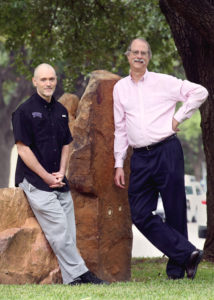Watch a brief video about the Fall 2018 Pedagogy in Practice on this topic.
The emerging discipline of Contemplative Studies and practice of “contemplative pedagogy” are increasingly being discussed at TCU and in academia more broadly. Our presentation introduced Contemplative Studies (CS) and how one practices such pedagogy in the classroom (both actual exercises and practical teaching tips). We are aware that we need to be able to intellectually justify contemplative pedagogy to our colleagues—and demonstrate that it fits into, and even enhances, liberal arts education. Contemplative pedagogy is also a response to student interest in multiple ways of learning and increased self-knowledge, as well as widespread concerns about alleviating stress and promoting wellness in a culture of digital domination.
We began with a short two-part meditation exercise to both center ourselves and demonstrate a possible classroom practice. The first part was the 4-7-8 breathing exercise wherein one inhales deeply while counting to 4, holds the breath for a count of 7, and exhales for a count of 8. This can be done with eyes closed while sitting up straight in a chair and feet flat on the floor, as is the case with the second part of the exercise that was a five-minute “follow-the-breath” meditation. This is a common exercise of sitting silently and counting to 10 while following the breath. One counts 1 while inhaling, 2 while exhaling, and so on up to 10. One then begins again with 1. A number of professors, here and elsewhere, use such a practice to begin class (two minutes is also sufficient!).
Andy then introduced the emerging discipline of CS. He offered definitions of terms like “contemplation” (a broad array of ways of reflection and focusing attention, sometimes, but certainly not always, part of a religious tradition) and “mindfulness” (the present-centered and non- judgmental observation of one’s thoughts and feelings). He also described a variety of contemplative practices (from sitting and walking meditation to yoga and guided imagery exercises) and where mindfulness fits in this array of practices. Andy then discussed different ways of learning in terms used by CS: first (“subjective” or “experiential”),second (intersubjective or dialogical “deep listening”), and third person (“objective” information sharing) methods of learning, and showed that these approaches work together to enrich classic liberal arts objectives such as critical thinking, reflective self-awareness, and value clarification. He noted that first-person exercises demonstrate the value of students being present to their own experience (mind and body) and encourage an increased understanding of both their own experience and others’ perspectives through direct self-reflexive thought and writing. The learning which arises through the above practices can be demonstrated by measurable artifacts such as journaling, short reaction papers, presentations, creative exercises, and summative semester-end writing.
We then looked at how CS has entered the health care world as “integrative medicine,” as seen in such institutions as the Center for Healthy Minds at the University of Wisconsin and the MD Anderson Cancer Center in Houston. Jane Torgerson MD, the director of TCU’s student health services, is board certified in integrative medicine, and the Dean and other administrators at the new Fort Worth Medical School are also very interested in integrating contemplative practices into their curriculum.
We then turned to evidence that contemplative practices also offer positive results for goals of individual and social well-being, such as increased capacity for focused attention, emotional regulation, mental and physical health, empathy, and resilience. These are especially important given the speed of change, stress, and (over) stimulation found among students (and American society) today. Contemplative exercises can raise awareness of our everyday distractedness, illustrating the limits of the overpraised (and largely false) notion of multitasking.
Mark then illustrated these points with clips from Dan Harris’s best-selling book 10% Happier, which he uses in his classes, and clips of neuroscientist Richard Davidson, Founder and Director of the University of Wisconsin’s Center for Healthy Minds, discussing happiness and compassion meditation.
After a group practice of the well-known guided “metta” or “loving kindness” meditation (wishing well-being to oneself and others, nearby and globally), Mark then described the development of the Contemplative Studies initiative at TCU, which was started by Andy in 2012. We next went over a handout containing useful books and introductory practices which teachers could use in a wide variety of classrooms.
We ended with a practice called the “circle of reflection,”which Mark has used successfully in various classes, in which each participant sits in a circle, considers an important feeling or value like gratitude (or courage, fear, authenticity, freedom, anxiety, etc.) while holding a stone. The stone is passed around the group and each person expresses (in this case) gratitude to an important figure in their lives. This can be a powerful relationship-building exercise in smaller seminar classes. We closed by spending some time with Q&A.
For additional information on becoming involved with TCU’s Contemplative Studies group, please contact Mark Dennis at: m.dennis@tcu.edu. Please email Andy Fort at a.fort@tcu.edu for copies of the materials we presented at the workshop. You can also visit our Contemplative Frogs website.

This article was written by Mark Dennis, Associate Professor of Religion, and Andy Fort, Professor of Religion for the Spring 2019 Issue of Insights.